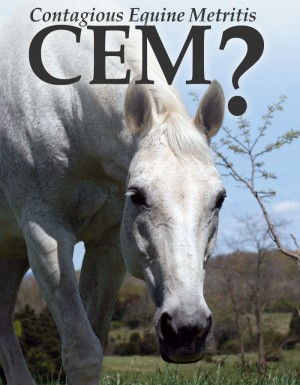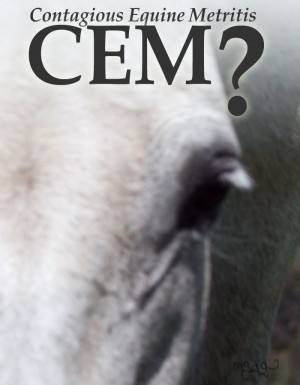CEM Mare Quarantine

Contagious equine metritis (CEM) is a venereal disease of horses caused by the bacteria Taylorella equigenitalis. It is spread during breeding or through contact with contaminated objects. This disease occurs very rarely in the United States and does not affect other livestock or people. However, it is highly contagious among horses and can be difficult to detect and control. Signs of illness in infected mares may not be obvious, and stallions carry the bacteria without showing any signs at all. CEM can have a negative impact on fertility in both mares and stallions. If the disease became widespread in the United States, the horse industry could suffer considerable economic losses.
In mares, the infection can appear in three general forms:
(1) Acute: Active inflammation of the uterus causes an obvious thick, milky, mucus discharge 10 to 14 days after breeding;
(2) Chronic: Milder uterine inflammation causes less obvious discharge, and infection may be more difficult to eliminate;
(3) Carrier: The bacteria are established in the reproductive tract. The mare, though not showing signs of illness, is still infectious and can remain a carrier for several months or longer.
Infected mares are likely to return to heat (estrus) more quickly than normal. CEM rarely causes abortion or permanent infertility in mares.
Stallions show no signs of the disease, but they can carry the bacteria for years, and it can survive in chilled and frozen semen.
There are three different ways to test for CEM: bacterial culture, blood testing, and test breeding. Bacterial culture tests look for the bacteria that cause CEM. Veterinarians collect swabs and send them to USDA approved diagnostic laboratories. Cultures require special handling and must be processed within 48 hours of collection. It takes 7 days to get a final negative result. Typically, the veterinarian will collect 3 sets of swabs during a 7 to 14 day period. Blood testing looks for an immune response to CEM, which helps determine if a horse has recently been exposed to the disease. This CEM complement fixation (CF) test can only be performed at the National Veterinary Services Laboratory (NVSL) in Ames IA, and is used only in mares because stallions do not develop an immune response to CEM. Test breeding is only used for detection of CEM in imported stallions.
NOTE: A written contract in advance is required in order to reserve a space for your mare. Please Call, Text, or eMail Dr. Ley to discuss this service, and to obtain a contract in advance of your mare's shipping date.
Dr. William B. Ley DVM, MS, DACT CEM Quarantine
Related Links
Allowed: 64M/67108864KB.
Current: 6251KB. Peak: 6321KB.




















